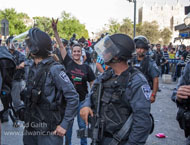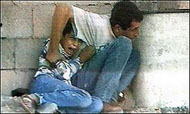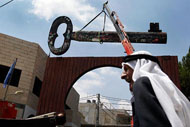Last weekend, Palestinian factions called a truce. They agreed to halt all attacks on Israelis for three months. Then, Israeli forces withdrew from the northern Gaza town of Beit Hanoun, a move significant because it opened up the main road there to Palestinians for the first time since September 2000. On Tuesday of last week, Prime Ministers Mahmoud Abbas and Ariel Sharon met, renewing commitments to the road map and an end to violence. Then, Israeli troops withdrew from Bethlehem. And now, Israel is proposing to release Palestinian prisoners. We are back on the road to peace.
Or are we? Because on Thursday morning, less than four days after withdrawing from Beit Hanoun, the Israeli army re-blocked the main thoroughfare of the Gaza Strip. Then, Israeli troops killed a Palestinian man. They were pursuing Ibrahim Mansour, an Al-Aqsa Brigades activist, who was critically wounded, and they killed his aide Mahmoud Shawer, aged 31, in the process. And even though Israeli troops have withdrawn from Bethlehem, its effects are limited. The main barrier to freedom in Bethlehem remains – in the form of checkpoints surrounding the city, cutting it off from the rest of the Occupied Territories, entrapping its residents. Finally, the list of prisoners being proposed for release amounts to a paltry 350 (out of some 6,000), more than half of whom are administrative detainees; stripped of their right to due process, they were never charged in the first place.
Still more colossal than these individual impediments to peace is the overarching cause of the current manifestation of the conflict in the first place: the occupation. Under the “road map” plan, Israel must start by withdrawing from areas it occupied after September 2000, and so the present back-and-forth is basically a negotiation to return to the pre-Intifada status. Before then, in the “Oslo years,” the Palestinian Authority had nominal control over just two-thirds of Gaza and only about 40 percent of the West Bank. What many are not discussing is that pre-Intifada conditions are what led to the Intifada in the first place. That is, justifiable Palestinian frustration with the occupation, lack of Palestinian autonomy, and Israeli aggression is what led to the uprising in September 2000.
What this means for Palestinians is that every time a baby step toward peace is taken – even in the seemingly rare cases when it is not rescinded or otherwise “undone” – very little actual progress is seen on the ground. For example, the withdrawal of troops from Bethlehem signifies little in the broader context of Israeli occupation, which results in everything from suffocating travel restrictions to poor access to education for Palestinians.
Despite all this, Palestinians keep hope. They await the Wednesday meeting of Prime Ministers Abbas and Sharon, who will discuss ways to advance the roadmap. And they anticipate more steps – giant steps – in the future.







